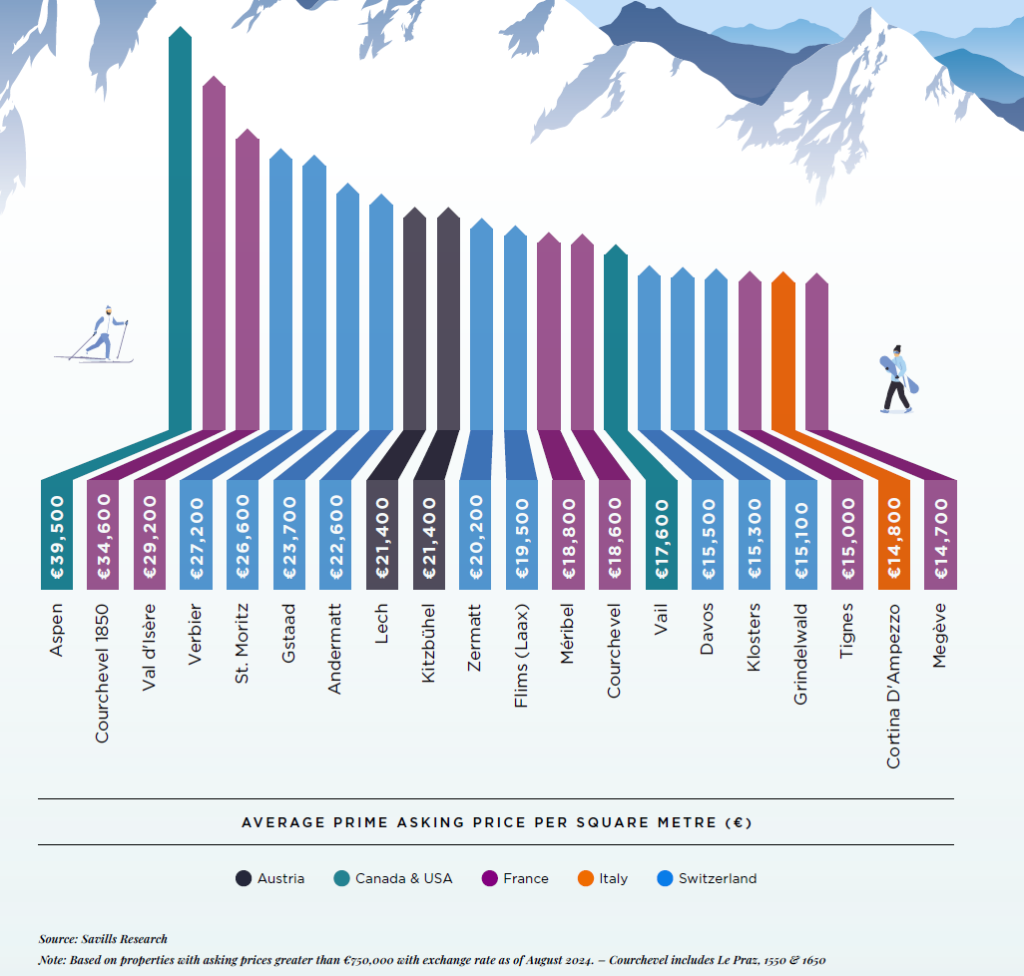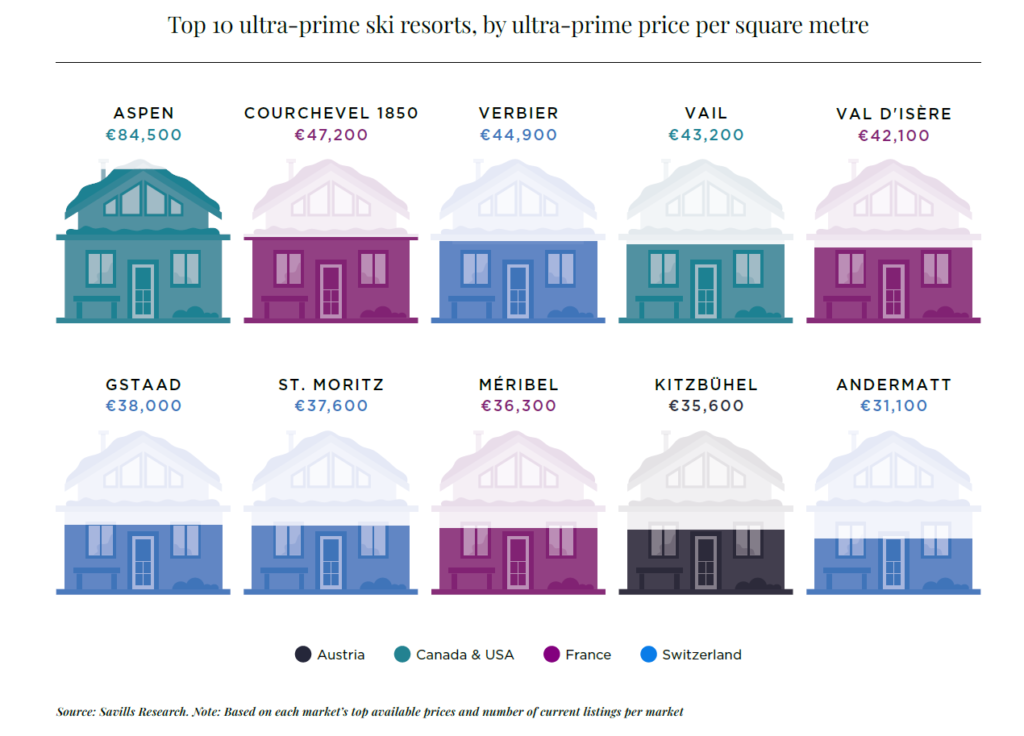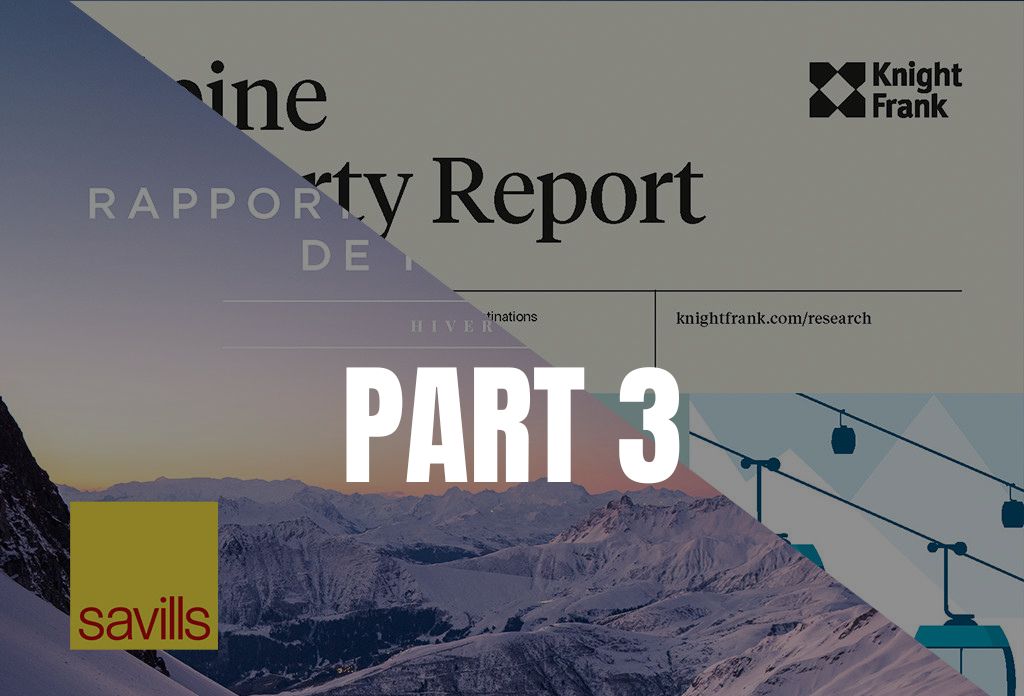As every year, the Savills and Knight Frank reports on the mountain real estate market have just been published. We have analyzed them in detail and are pleased to offer you a summary this month, enriched with our on-the-ground insights and some statistics on sales in Villars in 2024.
Despite a more complex financing environment, demand remains strong in Alpine resorts, particularly in the luxury and ultra-luxury segments. The scarcity of supply, combined with stricter banking requirements, now calls for thorough preparation and great responsiveness.
In this article, we review the current financing conditions, local market dynamics, and the strategies to adopt for making a purchase in 2025.
A Tight Mortgage Market…
The end of Q1 2025 marks a significant shift in central bank monetary policy. The decline in inflation across Europe has led the European Central Bank (ECB) to lower its key interest rates below 3%. At the same time, with an average annual increase of +1.1% in 2024, the Swiss National Bank (SNB) has cut its policy rate for the fifth consecutive time, now at 0.25%, as part of a deliberate strategy to weaken the Swiss franc and support business financing.
” Mortgage rates are hovering around 2% “
These decisions should have resulted in a significant drop in mortgage rates. However, in reality, securing real estate financing remains an uphill battle. Effective 10-year mortgage rates are still hovering around 2%, and lending conditions have tightened considerably.
Why? Banks, facing stricter regulatory requirements, must bolster their equity capital for every franc they lend. Furthermore, the increased concentration in the Swiss banking sector—amplified by UBS’s acquisition of Credit Suisse—has led to a general rise in lending margins. Today, UBS, Raiffeisen, and cantonal banks are lending less, at higher costs, and demanding more equity and guarantees—especially for properties requiring energy renovations. Energy efficiency requirements are becoming stricter, and banks are adjusting their lending policies accordingly.
At a national level, one in four homes in Switzerland is now equipped with a heat pump. In contrast, properties heated with oil or gas—representing 95% of the homes currently for sale in Villars—may require additional financial effort to secure financing.
Conclusion: The current landscape demands rigorous financial preparation. Your purchase offer will carry significantly more weight if accompanied by solid proof of financing. In today’s market, this is a decisive advantage!
Fewer Transactions, More Selectivity: A Tougher Market
At Gérance Service, we assist our clients daily in acquiring primary and secondary residences in the Vaud Alps. The reality is clear: since the end of the COVID crisis, the rules of the game have changed.
The numbers speak for themselves: between 2020 and 2023, the region averaged 190 sales per year. In 2024, this figure dropped to 124—a 35% decline.
 Despite this overall slowdown, certain market segments continue to perform well. High-end properties and newer apartments (built after 1990) still attract buyers, driven by an international clientele seeking vacation homes or relocating to the region. On the other hand, apartments in buildings over 40 years old are struggling to find buyers.
Despite this overall slowdown, certain market segments continue to perform well. High-end properties and newer apartments (built after 1990) still attract buyers, driven by an international clientele seeking vacation homes or relocating to the region. On the other hand, apartments in buildings over 40 years old are struggling to find buyers.
Inventory remains limited, with about 130 properties currently on the market, compared to over 230 before the pandemic. In this environment of scarcity, being ready to act quickly when an opportunity arises is more crucial than ever.
High-End & Ultra-High-End Market Overview
The High-End Segment
We rely on Savills Research’s classification of properties priced above 700,000 CHF.

Many Swiss Resorts in the Rankings
When it comes to sought-after locations for high-end investors, Switzerland remains the leader, closely followed by the French Alps.
The resorts of Verbier, Zermatt (Valais), and Gstaad (Bern) report average sale prices ranging from 19,000 CHF to 25,700 CHF per square meter. Similarly, St. Moritz (25,000 CHF per square meter) continues to attract international buyers, drawn by the historic quality of its slopes and exclusive lifestyle.
These five resorts have seen prices rise by over 4%, driven by demand fueled not only by financial investment but also by the security, lifestyle, comfort, and social status benefits that such an acquisition provides.
While prices are 2% lower than in 2022, they remain 36% higher than pre-COVID levels. A purchase in these areas represents both an attractive capital investment and a property with significant emotional value for many buyers.
And in Villars?
With a 1.7% annual price variation for chalets, Villars-sur-Ollon ranks 15th among the top-performing resorts according to the Knight Frank Alpine Property Index. At Gérance Service, we confirm a slight overall price increase, driven primarily by the luxury segment (properties over 1.5 million CHF).
The price per square meter in Villars-sur-Ollon ranges from 7,000 to 14,000 CHF.
Ultra-High-End: What Drives Buyers?
Switzerland’s Position in the Ultra-High-End Market
When it comes to the most expensive properties, Swiss ski resorts account for nearly half of the top 10 globally, with Verbier ranking third, followed by Gstaad, St. Moritz, and Andermatt. It’s worth noting that a significant portion of Switzerland’s most sought-after luxury properties are sold off-market, never appearing in public listings.

The Motivations of Ultra-Wealthy Buyers
The Alpine Sentiment Survey analyzed the views of 730 high-net-worth individuals from 13 countries, providing insight into their motivations, preferences, budgets, and aspirations.
Ultra-luxury demand (properties above 10 million euros) surged during the pandemic, as wealthy buyers sought increasingly exclusive retreats. The French-speaking Swiss Alps are experiencing strong demand in this segment, with a higher concentration of ultra-luxury homes than in the German-speaking parts of the country.
This premium clientele favors secluded properties that allow them to enjoy the mountains year-round rather than being close to main ski slopes. Proximity to an airport is essential for over half of surveyed buyers, and year-round activities are a key factor for nearly 50%.
These highly coveted chalets are concentrated in high-altitude areas with reliable snowfall and limited inventory. As climate change impacts snow reliability, interest in these exclusive locations is expected to grow, pushing prices even higher. Additionally, off-market transactions facilitate access for existing residents, and generational property transfers are increasingly preferred.
Foreign Investor Trends
Tax Policy Shifts & Political Influence on Ultra-Wealthy Buyers
The End of the UK’s Non-Dom Tax Regime
The UK government’s reforms of the non-domiciled tax regime continue to impact investment decisions for British buyers. Previously, this system provided major tax advantages for wealthy foreigners residing in the UK—which will no longer be the case.
UAE Investors on the Rise
Investors from the United Arab Emirates rank second among survey respondents. Their increasing interest in Alpine luxury real estate stems from a desire for financial diversification, stability, security, and a luxury-driven lifestyle.
Will Trump’s Return Boost European Resorts?
In the United States, a potential Trump re-election could positively impact real estate investments from American ultra-high-net-worth individuals. His past tax cuts (notably the 2017 tax reform) increased liquidity for wealthy Americans, leading some to diversify into international luxury real estate.
The Alps, with their world-renowned ski resorts, political stability, and economic security, remain an ideal destination for investors looking to protect their capital while enjoying an exclusive lifestyle.
At Villars-sur-Ollon, Gérance Service records 22% of sales to non-resident foreigners and 20% to resident foreigners.


